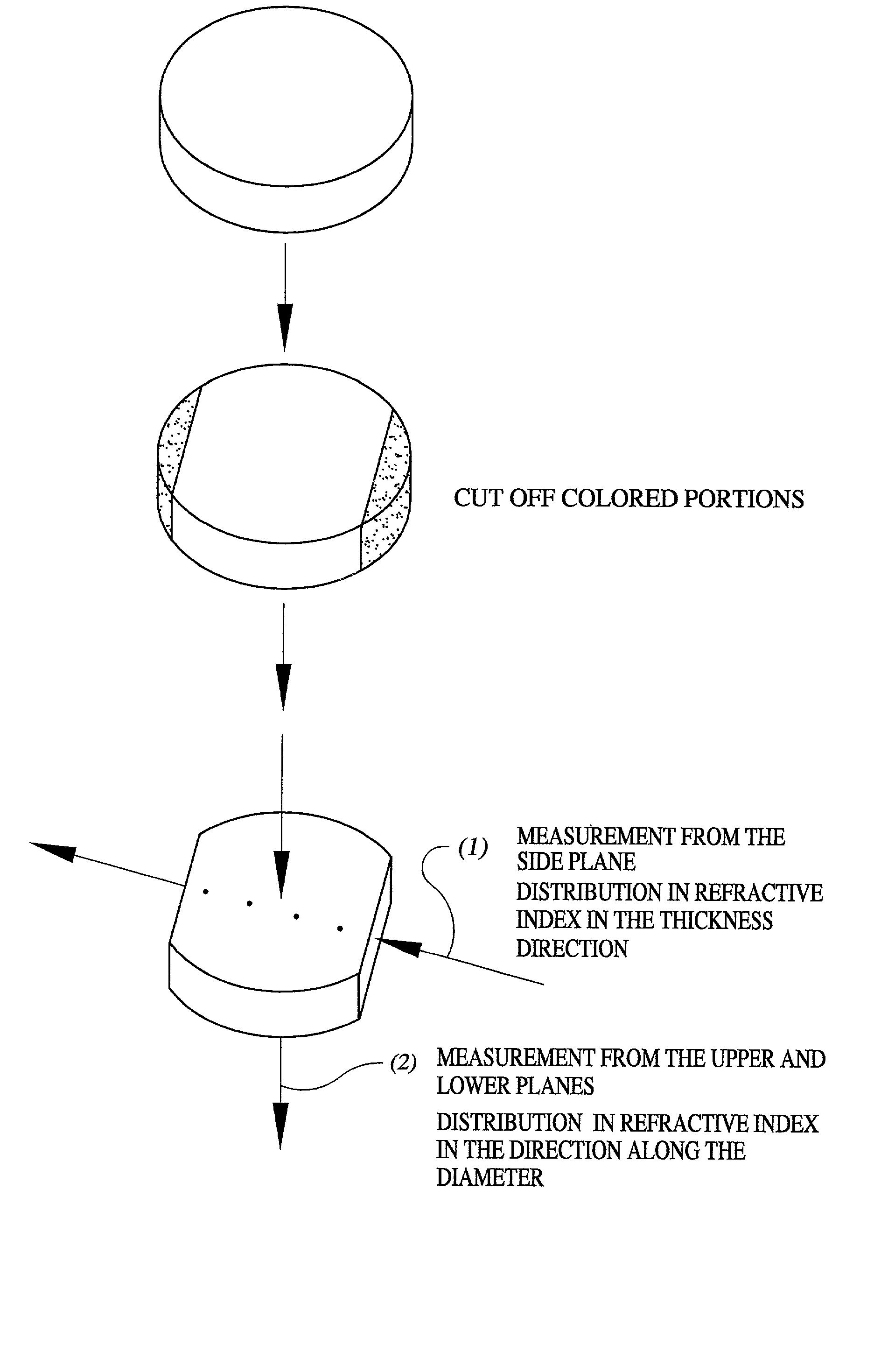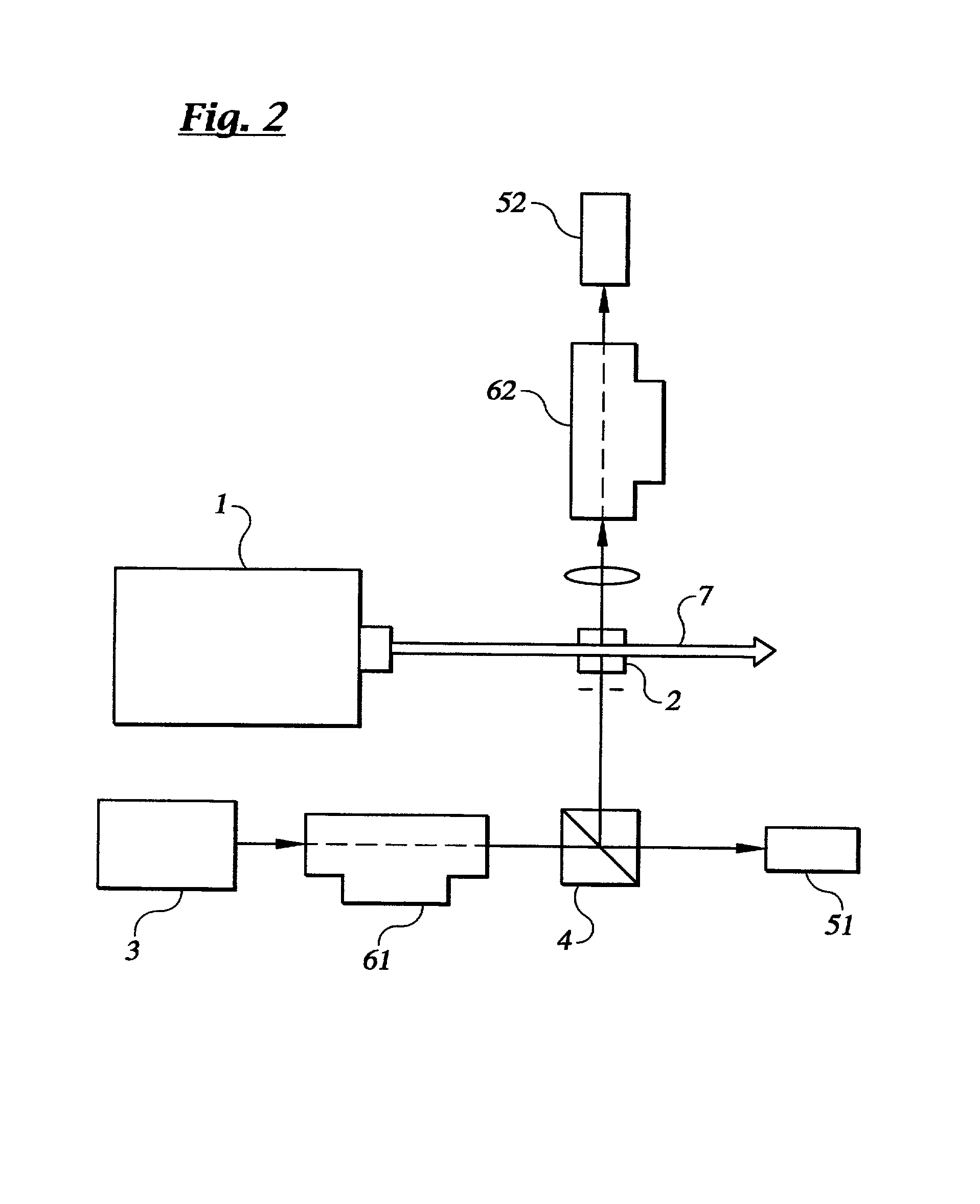Method for producing synthetic quartz glass members for excimer lasers and synthetic quartz glass members for excimer laser optics produced by the same
a laser optics and laser technology, applied in the direction of photomechanical equipment, manufacturing tools, instruments, etc., can solve the problems of insufficient means now being taken based on prior art for improving homogeneity or increasing laser resistance, affecting the homogeneity of hydrogen molecules, and affecting the quality of laser optics
- Summary
- Abstract
- Description
- Claims
- Application Information
AI Technical Summary
Problems solved by technology
Method used
Image
Examples
example 1
[0042] Fine particles of synthetic silica obtained by flame hydrolysis comprising introducing silicon tetrachloride into an oxyhydrogen flame were deposited as obtained on a rotating base body to obtain a porous silica preform (indirect flame hydrolysis method). Subsequently, the porous silica preform thus obtained was heated to 1600.degree. C. or higher in a vacuum furnace under a high vacuum of 10.sup.-4 Torr in pressure to obtain a transparent ingot. The ingot thus obtained was maintained at a temperature of 1800.degree. C. under nitrogen in an electric furnace equipped with a carbon heater, such that the ingot might be molten and shaped into a disk. The size of the shaped body was 260 mm in diameter and 60 mm in thickness. The outer surface of the thus obtained shaped body was cut to a depth of 10 mm to obtain a quartz glass body 240 mm in diameter and 40 mm in thickness. Then, to remove stress and for the homogenization of the quartz glass body thus obtained, the body was heate...
example 2
[0047] Fine particles of synthetic silica obtained by flame hydrolysis comprising introducing silicon tetrachloride into an oxyhydrogen flame were molten and deposited on a rotating base body to obtain an ingot of transparent glass body (direct flame hydrolysis method). Subsequently, the transparent glass ingot was maintained at a temperature of 1800.degree. C. in an electric furnace equipped with a carbon heater under nitrogen to melt and shape the ingot into a disk. The size of the shaped body was 260 mm in diameter and 65 mm in thickness. Then, in order to once degas the hydrogen molecules initially contained inside the shaped body, the shaped body was maintained in an electric furnace in air at a temperature of 1150.degree. C. for a duration of 250 hours. Subsequent to the heat treatment, the shaped body was gradually cooled to a temperature of 900.degree. C. at a cooling rate of 5.degree. C. / hour in order to remove stress and for the homogenization, at which the electric curren...
example 3
[0049] A transparent disk-shaped glass body 240 mm in diameter and 25 mm in thickness was prepared by using a method similar to those described in Example 2, comprising dehydrogenation thermal annealing of the quartz glass ingot obtained by direct flame hydrolysis. The hydrogen concentration thus found on the quartz glass body was below the detection limit; the homogeneity of the refractive index in the direction of thickness (as measured from the side plane) was .+-.1.2.times.10.sup.-6 as expressed by .DELTA.n, and the homogeneity in the direction of diameter (as measured from the upper and the lower planes) was .+-.0.9.times.10.sup.-6 as expressed by .DELTA.n.
[0050] In order to introduce hydrogen molecules into the shaped body thus obtained, heat treatment was performed in a hydrogen treatment furnace. The conditions of the treatment were set as such that the heating was maintained in an atmosphere containing 100% hydrogen molecules at a temperature of 350.degree. C. under a press...
PUM
| Property | Measurement | Unit |
|---|---|---|
| pressure | aaaaa | aaaaa |
| pressure | aaaaa | aaaaa |
| temperature | aaaaa | aaaaa |
Abstract
Description
Claims
Application Information
 Login to View More
Login to View More - R&D
- Intellectual Property
- Life Sciences
- Materials
- Tech Scout
- Unparalleled Data Quality
- Higher Quality Content
- 60% Fewer Hallucinations
Browse by: Latest US Patents, China's latest patents, Technical Efficacy Thesaurus, Application Domain, Technology Topic, Popular Technical Reports.
© 2025 PatSnap. All rights reserved.Legal|Privacy policy|Modern Slavery Act Transparency Statement|Sitemap|About US| Contact US: help@patsnap.com



